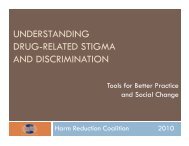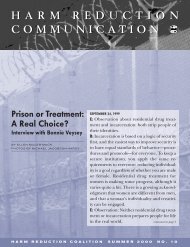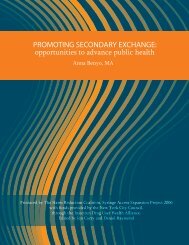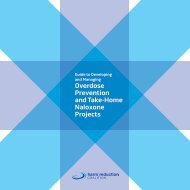9th - Harm Reduction Coalition
9th - Harm Reduction Coalition
9th - Harm Reduction Coalition
Create successful ePaper yourself
Turn your PDF publications into a flip-book with our unique Google optimized e-Paper software.
<strong>9th</strong><br />
National <strong>Harm</strong> <strong>Reduction</strong> Conference<br />
FROM PUBLIC HEALTH TO SOCIAL JUSTICE<br />
Patti Davis, CADCII, has more than 20 years of experience working with youth and adolescents. She has worked with the Homeless<br />
Youth Continuum in Portland, Oregon since 2001. Her current program, Project Metamorphosis, is an innovative collaborative<br />
project that brings chemical dependency and mental health services to street-entrenched youth. She is the current chair for Mt.<br />
Hood Community College advisory board, and sits on the Steering Committee for Commercially Sexually Exploited Children.<br />
Gaeta, Andres, Mexican <strong>Harm</strong> <strong>Reduction</strong> Network, Tijuana, Mexico<br />
andres.gaeta@gmail.com<br />
Deportación y drogas inyectables en frontera<br />
Tijuana es la frontera con mayor tránsito a nivel mundial y principal puerto de deportación de Estados Unidos (EEUU) a<br />
México. El Departamento-de-Seguridad de EEUU reportó para 2010 354,982 deportaciones; el Instituto-Nacional-de-Migración<br />
de México reportó 405,455 deportaciones en 2011 y entre Enero-Febrero de 2012 se reportaron 1,000 deportaciones<br />
diarias. Alrededor del 50% de los deportados se quedan viviendo en zonas marginales de Tijuana, compartiendo condiciones<br />
de vulnerabilidad con usuarios de drogas inyectadas (UDI). Encuestas realizadas entre 2005-2007 con UDI en Tijuana encontraron<br />
que entre 30 y 40% de la muestra eran personas deportadas con menos de un año viviendo en Tijuana. Los datos<br />
demuestran que UDIS migrantes tienen 2.55 veces mayor probabilidad de vivir con VIH que aquellos nacidos en Tijuana<br />
(p=0.02). Los usuarios con menor tiempo viviendo en Tijuana, tienen dos veces mayor probabilidad de haber compartido jeringas<br />
que aquellos con mayor tiempo viviendo en la ciudad (p=0.00). Se encuentra prevalencia de VIH de 4% y de Hepatitis-C<br />
(VHC) de arriba del 95%. El uso de drogas inyectadas, el aumento de VIH y VHC son problemas de salud pública binacional<br />
dada la porosidad de la frontera México-Estados Unidos. La criminalización de población migrante y la deportación unilateral<br />
son factores que contribuyen al aumento de condiciones de riesgo y vulnerabilidad en Tijuana, siendo urgente diseñar<br />
intervenciones de reducción de daños y una estrategia de deportación coordinada entre México y EEUU, involucrando a los<br />
ministerios de salud pública para prevenir la expansión del VIH y VHC en la frontera.<br />
Secretary of the Mexican <strong>Harm</strong> <strong>Reduction</strong> Network, work at Ser, A.C. a local CBO has <strong>Harm</strong> <strong>Reduction</strong> coordinator, also coordinating<br />
interviewers in a research with Female Sex Workers. Certificated in Drug Addiction and related harms in 2012, Graduated in<br />
2011 as Clinic Psychologist, have worked in HIV prevention programs with young male deprived of liberty, and also applying rapid<br />
HIV test. In 2010 collaborate in a research about the consistent condom use among young population.<br />
Gale, Chloe, Evergreen Treatment Services, Seattle, WA<br />
chloeg@etsreach.org<br />
Outreach Off of the Grid: Creative Engagement Strategies using <strong>Harm</strong> <strong>Reduction</strong> Models<br />
Can we find and connect with people who are deliberately hiding from the institutions that alienate and stigmatize them<br />
Once we find them, how do we identify and assess individuals with high needs and link them to support services Using a<br />
non-judgmental client-centered approach, our outreach team includes a nurse and case managers who slowly build trust<br />
and rapport in extremely marginalized communities. In order to really meet people where they are, we have workers who<br />
specialize in reaching out to different groups, including IDUs, people with HIV/AIDS, Spanish speaking adults, Native Americans,<br />
and Veterans. We rely on staff expertise as well as relationships within the street community to help us identify and<br />
build trust with isolated, apprehensive individuals. Once connected, our extensive community collaborations allow us to find<br />
the best possible fit to bring support to people with extremely complicated lives. Our model addresses staff safety and support<br />
to sustain the work in spite of the challenges encountered around an active drug using lifestyle.<br />
Creating an Effective Work Environment: <strong>Harm</strong> <strong>Reduction</strong> and Staff Resiliency<br />
To be discussed is how our program addresses the risks/impact on us as caregivers for individuals who have long histories<br />
of addiction, trauma and marginalization. We are intentional about fostering an organizational culture that draws on each<br />
team member’s perspectives and strengths and have high staff retention and satisfaction. Even so, the work can be difficult<br />
44











